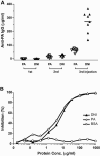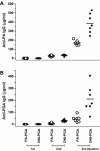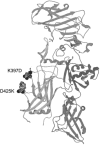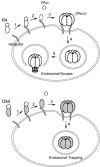Combining anthrax vaccine and therapy: a dominant-negative inhibitor of anthrax toxin is also a potent and safe immunogen for vaccines
- PMID: 15908368
- PMCID: PMC1111877
- DOI: 10.1128/IAI.73.6.3408-3414.2005
Combining anthrax vaccine and therapy: a dominant-negative inhibitor of anthrax toxin is also a potent and safe immunogen for vaccines
Abstract
Anthrax is caused by the unimpeded growth of Bacillus anthracis in the host and the secretion of toxins. The currently available vaccine is based on protective antigen (PA), a central component of anthrax toxin. Vaccination with PA raises no direct immune response against the bacilli and, being a natural toxin component, PA might be hazardous when used immediately following exposure to B. anthracis. Thus, we have sought to develop a vaccine or therapeutic agent that is safe and eliminates both secreted toxins and bacilli. To that end, we have previously developed a dually active vaccine by conjugating the capsular poly-gamma-d-glutamate (PGA) with PA to elicit the production of antibodies specific for both bacilli and toxins. In the present report, we describe the improved potency of anthrax vaccines through the use of a dominant-negative inhibitory (DNI) mutant to replace PA in PA or PA-PGA vaccines. When tested in mice, DNI alone is more immunogenic than PA, and DNI-PGA conjugate elicits significantly higher levels of antibodies against PA and PGA than PA-PGA conjugate. To explain the enhanced immunogenicity of DNI, we propose that the two point mutations in DNI may have improved epitopes of PA allowing better antigen presentation to helper T cells. Alternatively, these mutations may enhance the immunological processing of PA by altering endosomal trafficking of the toxin in antigen-presenting cells. Because DNI has previously been demonstrated to inhibit anthrax toxin, postexposure use of DNI-based vaccines, including conjugate vaccines, may provide improved immunogenicity and therapeutic activity simultaneously.
Figures




Similar articles
-
Investigation of new dominant-negative inhibitors of anthrax protective antigen mutants for use in therapy and vaccination.Infect Immun. 2009 Oct;77(10):4679-87. doi: 10.1128/IAI.00264-09. Epub 2009 Jul 20. Infect Immun. 2009. PMID: 19620345 Free PMC article.
-
Selection and evaluation of the immunogenicity of protective antigen mutants as anthrax vaccine candidates.Vaccine. 2008 Feb 13;26(7):947-55. doi: 10.1016/j.vaccine.2007.11.087. Epub 2007 Dec 26. Vaccine. 2008. PMID: 18192092 Free PMC article.
-
Poly-gamma-d-glutamic acid and protective antigen conjugate vaccines induce functional antibodies against the protective antigen and capsule of Bacillus anthracis in guinea-pigs and rabbits.FEMS Immunol Med Microbiol. 2009 Nov;57(2):165-72. doi: 10.1111/j.1574-695X.2009.00595.x. Epub 2009 Aug 6. FEMS Immunol Med Microbiol. 2009. PMID: 19732139
-
A dually active anthrax vaccine that confers protection against both bacilli and toxins.Proc Natl Acad Sci U S A. 2003 Sep 16;100(19):10925-30. doi: 10.1073/pnas.1834478100. Epub 2003 Sep 5. Proc Natl Acad Sci U S A. 2003. PMID: 12960361 Free PMC article.
-
Progress and novel strategies in vaccine development and treatment of anthrax.Immunol Rev. 2011 Jan;239(1):221-36. doi: 10.1111/j.1600-065X.2010.00969.x. Immunol Rev. 2011. PMID: 21198675 Review.
Cited by
-
From structure to solutions: the role of basic research in developing anthrax countermeasures: Microbiology Graduate Program Seminar: Anthrax toxin.Yale J Biol Med. 2012 Jun;85(2):285-92. Epub 2012 Jun 25. Yale J Biol Med. 2012. PMID: 22737057 Free PMC article.
-
A FRET-based high throughput screening assay to identify inhibitors of anthrax protective antigen binding to capillary morphogenesis gene 2 protein.PLoS One. 2012;7(6):e39911. doi: 10.1371/journal.pone.0039911. Epub 2012 Jun 29. PLoS One. 2012. PMID: 22768167 Free PMC article.
-
Investigation of new dominant-negative inhibitors of anthrax protective antigen mutants for use in therapy and vaccination.Infect Immun. 2009 Oct;77(10):4679-87. doi: 10.1128/IAI.00264-09. Epub 2009 Jul 20. Infect Immun. 2009. PMID: 19620345 Free PMC article.
-
Structural and biological characterization of a capsular polysaccharide produced by Staphylococcus haemolyticus.J Bacteriol. 2008 Mar;190(5):1649-57. doi: 10.1128/JB.01648-07. Epub 2007 Dec 28. J Bacteriol. 2008. PMID: 18165309 Free PMC article.
-
Selection and evaluation of the immunogenicity of protective antigen mutants as anthrax vaccine candidates.Vaccine. 2008 Feb 13;26(7):947-55. doi: 10.1016/j.vaccine.2007.11.087. Epub 2007 Dec 26. Vaccine. 2008. PMID: 18192092 Free PMC article.
References
-
- Anonymous. 2000. Use of anthrax vaccine in the United States. Morb. Mortal. Wkly. Rep. 49(RR-15):1-20. - PubMed
-
- Benson, E. L., P. D. Huynh, A. Finkelstein, and R. J. Collier. 1998. Identification of residues lining the anthrax protective antigen channel. Biochemistry 37:3941-3948. - PubMed
-
- Bradley, K. A., J. Mogridge, M. Mourez, R. J. Collier, and J. A. Young. 2001. Identification of the cellular receptor for anthrax toxin. Nature 414:225-229. - PubMed
Publication types
MeSH terms
Substances
Grants and funding
LinkOut - more resources
Full Text Sources
Other Literature Sources
Medical

